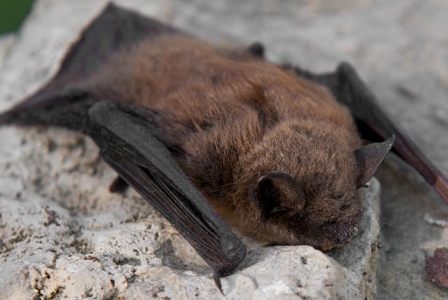
These not-so-scary harbingers of Halloween are in trouble! Learn why on this Wildlife Wednesday.
Well, aren’t they, uh, creepy? Let’s get into the Halloween spirit on this Wildlife Wednesday by getting the scoop about little brown bats—the cutest, fuzziest, and least spooky bats that you ever did see.
Habitat
These fuzzy little flyers can be found roosting in caves, abandoned mines, and other hollows throughout most of Canada, the US, and Mexico.
Trivia
- Even as far as bats are concerned, little brown bats are mosquito-eating champions. A single bat can chomp down on up to 600 mosquitoes in one hour. During the summer months, they can eat as much as half of their own weight in insects each night.
- As a general rule, bats have unusually long lifespans for animals of their size. These little mosquito-eating machines in particular are long lived—they can keep on with their mosquito eating for more than 30 years!
- Unlike some bat species, little brown bats don’t migrate to prepare for the cold weather. Instead, they find specific hollows where the humidity and temperature are relatively high, and hibernate until the spring comes around.
- Like other bats, though, these little fellows can see quite well. Unfortunately, this also means that they probably saw George Clooney in Batman & Robin.
Why are they threatened?
In the past, the bat’s large numbers and ability to adapt to human settlement meant that they, overall, thrived in wild and rural settings alike. However, all that has changed over the past five years or so.
A disease known as white-nose syndrome, caused by a specific type of cold-loving fungus, is spreading through bat colonies throughout Canada and the US; confirmed cases have been found in Ontario, New Brunswick, Nova Scotia, and Quebec, as well as 25 US states. Some reports claim that the deadly disease can infect entire colonies while they hibernate.
White-nose syndrome affects the bats by disrupting their hibernation cycle, causing them to use up the extra body fat that they manage to accumulate before spring arrives. Researchers also suspect that the disease affects the bat’s ability to retain water, meaning that thirst wakes them from hibernation.
Right now, Canadian and American researchers are working together to try to stop the spread of white-nose syndrome and find treatment options for these fuzzy little insectivores. Bat-lovers who see bats flying outside in the middle of winter, or with a white, powdery-looking substance on their nose or wings, should give these not-so-scary harbingers of Halloween a hand by leaving a message with their local wildlife centre.















